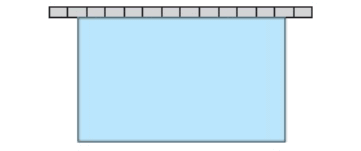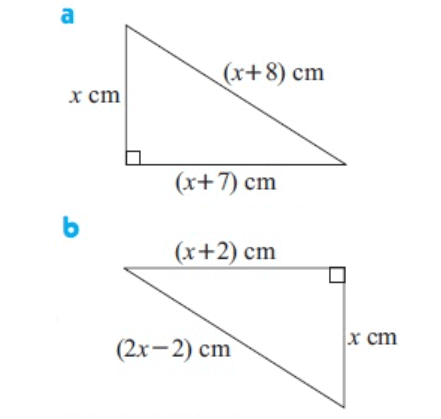SOLVING WORD PROBLEMS USING PYTHAGOREAN THEOREM
Subscribe to our ▶️ YouTube channel 🔴 for the latest videos, updates, and tips.
Example 1 :
A rectangle has length 6 cm greater than its width. Find its width given that its area is 91 cm2
Solution :
Let, width = x cm and length = (x+6) cm
Area = 91 cm2
Area of a rectangle = length × width
x (x + 6) = 91
x2 + 6x – 91 = 0
By factorization, we get
(x + 13) (x – 7) = 0
x + 13 = 0 or x – 7 = 0
x = - 13 or x = 7
Since the side length cannot be considered with negative sign. Width can be 7 cm.
Example 2 :
A triangle has base 2 cm more than its altitude. If its area is 49.5 cm2, find its altitude.
Solution :
Let, altitude = x cm and base = (x + 2) cm
Area = 49.5 cm2
Area of a triangle = 1/2 (base × altitude)
1/2 [(x+2) . x] = 49.5
1/2 (x2+2x) = 49.5
x2+2x = (49.5 × 2)
x2 + 2x = 99
x2 + 2x – 99 = 0
By factorization, we get
(x + 11) (x – 9) = 0
x + 11 = 0 or x – 9 = 0
x = - 11 or x = 9
we taking positive value x = 9 cm
altitude
= 9 cm
So, its altitude is 9 cm.
Example 3 :
A rectangular enclosure is made from 40 m of fencing. The area enclosed is 96 m2. Find the dimensions of the enclosure.

Solution :
Let, length = x m and width = y m of rectangular enclosure.
If perimeter is 40 m
Perimeter of rectangle = 2(l + w)
2(x + y) = 40
x + y = 20 -----(1)
Area = 96 m2
xy = 96
y = 96/x -----(2)
By applying y = 96/x in equation (1), we get
x + 96/x = 20
x2 + 96 = 20x
x2 – 20x + 96 = 0
By factorization, we get
(x – 12) (x – 8) = 0
x = 12 m or 8 m
x = 12 m
Now, length x = 12 m
By applying x = 12 m in equation (1), we get
y = 96/x
y = 96/12
y = 8 m
width y = 8 m
So, dimensions of the enclosure 12 m × 8 m
Example 4 :
Use the theorem of Pythagoras to find x given :

Solution :
By using Pythagorean theorem,
AB2 + BC2 = AC2
x2+(x+7)2 = (x+8)2
x2+x2+14x+49 = x2+16x+64
2x2+14x+49–x2–16x–64 = 0
x2–2x–15 = 0
By factorization, we get
(x–5) (x+3) = 0
x = 5 or – 3
So, the value of
x is 5
b) By using Pythagorean theorem,
AB2 + BC2 = AC2
(x+2)2 + x2 = (2x-2)2
x2+4x+4+x2 = 4x2-8x+4
2x2+4x+4–4x2+8x–4 = 0
- 2x2 + 12x = 0
- 2x(x - 6) = 0
x - 6 = 0
Now, x = 6
So, the value of x is 6
Example 5 :
A right angled triangle has sides 2 cm and 9 cm respectively less than its hypotenuse. Find the length of each side of the triangle.
Solution :
Let x = hypotenuse c,
then a = (x–2) cm and b = (x–9) cm
In right angled triangle, using Pythagorean theorem
a2+b2 = c2
(x–2)2 + (x–9)2 = x2
x2-4x+4+x2-18x+81 = x2
2x2–22x+85–x2 = 0
x2–22x+85 = 0
By factorization, we get
(x–5) (x–17) = 0
x = 5 or 17
In any right triangle hypotenuse is the longest side. So, we take x as 17 cm.
hypotenuse c = 17 cm
then a = (x – 2) cm
a = 15 cm
b = (x–9) cm
b = 8 cm
So, each side of the triangle are 8 cm, 15 cm, 17 cm.
Example 6 :
A gardener plants 600 cabbage in rows. If the number of cabbages in each row is 10 more than twice the number of rows, how many rows did the gardener plant ?
Solution :
Let x = number of rows
The number of cabbage in each row is 10 + 2x
Total number of cabbage is 600, then
x(10 + 2x) = 600
10x + 2x2 = 600
2x2 + 10x – 600 = 0
x2 + 5x – 300 = 0
(x + 20) (x – 15) = 0
x = - 20 or 15
x = 15 rows
So, the number of rows is 15
Subscribe to our ▶️ YouTube channel 🔴 for the latest videos, updates, and tips.
Kindly mail your feedback to v4formath@gmail.com
We always appreciate your feedback.
About Us | Contact Us | Privacy Policy
©All rights reserved. onlinemath4all.com
Recent Articles
-
Specifying Units of Measure
Dec 15, 25 07:09 PM
Specifying Units of Measure -
Quantitative Reasoning Questions and Answers
Dec 14, 25 06:42 AM
Quantitative Reasoning Questions and Answers -
Coin Tossing Probability
Dec 13, 25 10:11 AM
Coin Tossing Probability - Concept - Sample Space - Formula - Solved Problems